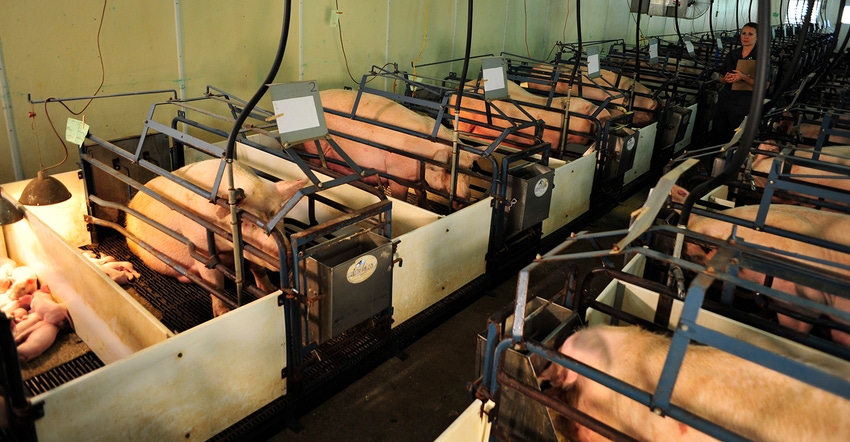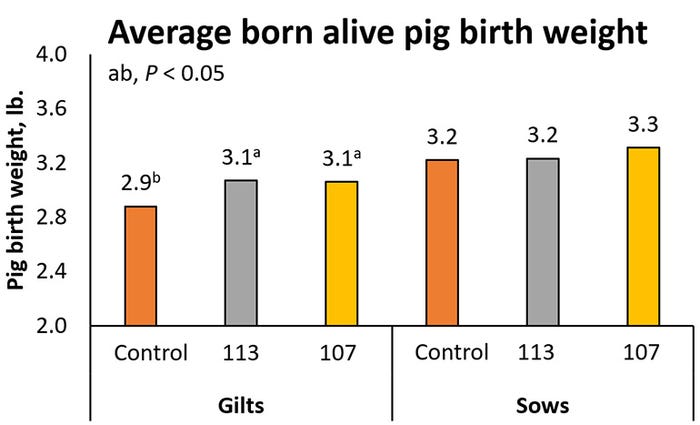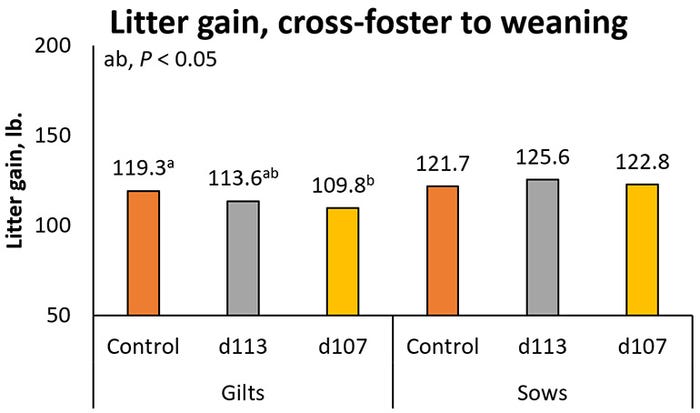Can short bump of feed improve performance in lactation?
Ad libitum feeding a lactation diet to gilts entering the farrowing house may be adequate to meet additional lysine, energy requirements for fetal growth.
March 12, 2020

In recent years, a large emphasis has been placed on understanding the requirements of high-producing sows. While several studies have been conducted to evaluate changing nutrient requirements in late gestation (Day 90 to parturition) and lactation, few studies have focused on the few days immediately prior to lactation. The transition period has been loosely defined as the last 10 days of gestation to the first 10 days of lactation, with most studies involving transition diets starting to be fed between Day 104 and 109 of gestation.
Currently in U.S. swine production, it is not common to feed a specific transition diet. However, nutrient partitioning changes rapidly in the last 10 days prior to parturition with fetal growth (22.7%), mammary growth (16.8%) and colostrum production (16.1%) representing the majority of the total required standardize ileal digestible lysine in late gestation. Based on a recent study by Feyera et al. (2017), relative to Day 104 of gestation, metabolizable energy and SID lysine requirements increased by 60% and 149% at Day 115 of gestation, respectively.
These researchers predicted that the ME and SID lysine requirement on the last day of gestation is approximately 13.3 Mcal of ME and 35 grams of SID lysine. This is a significant increase in energy and lysine required compared to what is typically provided in production today and when not met through dietary intake, the sow will mobilize her own body reserved to satisfy requirements. However, is there a feeding strategy during the transition period that can minimize the gap in supplied nutrients and required nutrients?
The objective of the current experiment was to determine the impact of different feeding durations of increased SID lysine and energy immediately prior to farrowing on colostrum production, sow and litter performance, and piglet survival. A total of 467 sows (Large White-Landrace cross) were used at a commercial sow farm in southern Minnesota. On Day 106 of gestation, sows were weighed and assigned to one of three feeding regimens. Feeding regimens consisted of: 1) 4.5 pounds per day gestation feed (12.5 g SID lysine and 6.5 Mcal ME) until Day 113 of gestation, then 6 pounds per day lactation feed (28 g SID lysine and 9.4 Mcal ME) until parturition; 2) 4.5 pounds per day gestation feed (12.5 g SID lysine and 6.5 Mcal ME) until Day 113 of gestation, then 8.3 pounds per day lactation feed (40 g SID lysine and 13.3 Mcal ME) until parturition; and 3) 8.3 pounds per day lactation feed (40 g SID lysine and 13.3 Mcal ME) from Day 107 of gestation until parturition (Figure 1).

Feeding strategies continued until the sow farrowed, and then all sows received lactation diet ad libitum until weaning.
On Day 113 of gestation, gilts and sows that received 8.3 pounds per day lactation diet starting on Day 107 were 11 pounds heavier and gained more backfat than females on the control regimen. This was expected due to the increased lysine and energy provided to females beginning at Day 107 or Day 113 compared to the standard farm feeding levels. Previous studies that evaluated increased feeding strategies starting on Day 90 of gestation suggested that an additional 16.6 g/d SID lysine and 9.6 Mcal/d ME resulted in an additional 15 pounds of body weight gain.
While the dietary treatments in the current study would have been fed for a shorter duration, the much higher levels of SID lysine (40 g/d) and ME intake (13.3 Mcal/d) resulted in similar body weight gain as those where feed intake was increased from Day 90 of gestation to farrowing. There was no difference in female body weight or backfat loss during the lactation period between treatments.
Average piglet birth weight was greater in gilts fed 8.3 pounds per day lactation diet starting on Day 107 or 113 versus the control feeding regimen, with no difference in average piglet birth weight in sow litters (Figure 2).

Piglet mortality to weaning was decreased in sows fed 8.3 pounds per day lactation diet starting on Day 113 versus the other two feeding regimens, but not different in gilts. However, litter gain from 48 hours to weaning was decreased in gilts fed 8.3 pounds per day lactation diet starting on Day 107 compared to control, with no difference in sows (Figure 3).

This was unexpected due to the heavier birth weights observed in pigs fed additional feed prior to farrowing but may be a factor of an over-conditioned herd (20 mm backfat at Day 113 of gestation). Individual lactation feed intake was unable to be measured with the automated feeding system on this commercial sow farm. Thus, it is unknown if increased backfat and body weight prior to farrowing negatively affected lactation feed intake, and thus milk output and litter gain as previous studies would suggest. Wean-to-estrus interval, percentage of females in estrus by Day 7, farrowing rate, or subsequent litter characteristics was not different among sows fed different feeding regimens prior to farrowing.
For colostrum composition, fat and total solids were decreased in sows fed 8.3 pounds per day of the lactation diet starting on Day 107 compared to the control regimen, with no difference observed in gilts. There was no difference in colostrum protein or lactose concentrations due to dietary treatment. Colostrum immunoglobulin G was increased in gilts and sows fed 8.3 pounds per day of the lactation diet starting on Day 113 compared to control regimen. Piglet colostrum intake and colostrum yield was not different due to dietary regimen fed pre-farrow.
In summary, providing high lysine and energy intake from Day 107 or 113 to farrowing increased piglet birth weight in gilts; however, litter gain to weaning was reduced when gilts started on high lactation feed intake at Day 107 compared to gilts not fed increased lysine and energy. Providing high lysine and energy intake from Day 113 increased pre-weaning piglet survival in sows. Colostrum intake and yield, and subsequent reproductive performance were unaffected by dietary treatments.
In conclusion, ad libitum feeding of a lactation diet when gilts are loaded into the farrowing house may be adequate to meet the additional lysine and energy requirements for fetal growth. Piglet mortality to weaning was decreased in sows fed 8.3 pounds per day lactation diet starting on Day 113. Thus further research is needed to determine why differences in responses were seen in gilts versus sows, and if a higher body condition of gilts at farrowing is a factor in these results.
Sources: Kiah M. Gourley, Analicia J. Swanson, Jason C. Woodworth, Joel M. DeRouchey, Mike D. Tokach, Steve S. Dritz and Robert D. Goodband, who are solely responsible for the information provided, and wholly own the information. Informa Business Media and all its subsidiaries are not responsible for any of the content contained in this information asset.
You May Also Like



